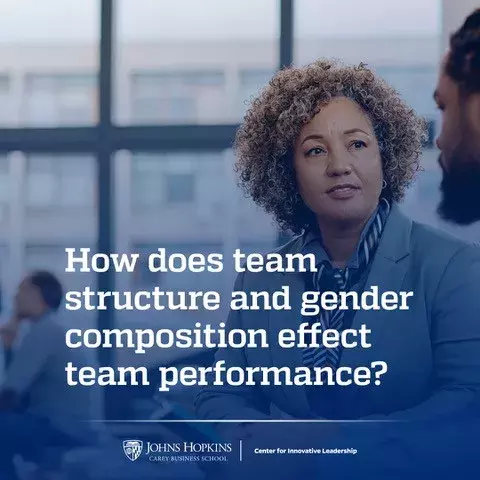Leaders seeking to foster inclusivity should be aware that a team’s collective intelligence—its general ability to make decisions, innovate, plan, and more—is significantly influenced by its hierarchal structure and also by its gender composition.

How Structure and Gender Composition Effect A Team’s Collective Ability to Get Work Done
Summary
A team’s general ability to perform across a wide range of tasks—from creative endeavors to complex decision making to planning and execution—is known as its ‘collective intelligence.’ One key factor predicting a team’s collective intelligence, and thus likely effectiveness, is the team’s ‘collective attention,’ or the extent to which team members are jointly attending to the task and each other.
A recent study has investigated how a team’s structure, particularly its hierarchy, leads to different displays of collective attention—evidenced through different speaking patterns. The authors found that stable hierarchies increased cooperative, harmonious speaking patterns; whereas teams with unstable hierarchies, where a leader could be unseated, exhibited more competitive, interruptive speaking patterns. But both, it turns out, could reflect collective attention depending on group norms. For majority female groups, more cooperative speaking patterns captured their collective attention and predicted their collective intelligence; but in all-male groups, it was the more competitive pattern of speaking that indicated collective attention and predicted intelligence. Understanding these dynamics—the influence of a team’s hierarchy and its composition—can help organizations design teams and establish effective norms to support collective intelligence and performance within an inclusive environment.
Teams and teamwork are fundamental to how organizations operate. Developments over recent years—flatter management structures, remote working, efforts towards diversity and inclusion—have added to the complexity for leaders looking to maximize team performance, calling for a better understanding of the drivers of team success in these new environments.
Collective Intelligence and Collective Attention
A principal factor in a team’s performance is its ‘ collective intelligence’ , a term used in biology to describe the behavior of bacteria and animals, and now also with humans. In humans, collective intelligence specifically refers to a team's general ability to work together and perform well on various tasks, from creative endeavors to complex decision making to planning and execution. Distinct from simply how talented or smart the individuals are, collective intelligence captures a team’s ability to be greater than the sum of its parts.
Previous research has shown that ‘collective attention’ along with two other cognitive functions—collective memory and collective reasoning—can explain why one team might have higher collective intelligence than another. A team’s level of collective attention refers to the quality and coordination of members’ focus. Collective attention is characterized by members’ joint attention to each other and to the task, thus increasing the combined thinking power focused on the coordinated effort required to accomplish team goals. At a time when the abundance of information brought through digitization along with seemingly endless distractions have taxed people’s personal attention span, it is especially important to seek ways to better manage attention in a collective, team context.
Competitive and Cooperative Team Dynamics
The way a team operates is established very early on in its existence, determined by the team’s composition, or traits of team members, and the team’s structure, such as its hierarchy. And while it is not always possible to choose a team’s members or to arrange its hierarchy, it is important that leaders are aware of these dynamics when creating and managing teams so that the current conditions can best be leveraged.
In a new study, Anna Mayo, an affiliate of the Center for Innovative Leadership at Johns Hopkins Business School, looked closely first at how team hierarchy influences collective attention and consequently collective intelligence, and secondly at the additional effect of the gender composition of team membership.
Mayo and colleagues randomly assigned 150 teams to work in stable, unstable, or unspecified hierarchical structures and various gender compositions, and they recorded different behavioral manifestations of collective attention as evidenced in each team’s speaking patterns.
The type of hierarchy a team has is part of its foundational structure. A hierarchy provides team members with a guide to knowing who does what, when, and how, who takes the lead and who to defer to—expectations that have implications for collective attention. Yet, while many have looked at the type of leader or the steepness of the hierarchy, this study looked specifically at the effect of the ‘stability’ of the hierarchy.
Research findings suggested that the stable hierarchies facilitated cooperation such that team members interacted harmoniously, speaking in a more synchronous pattern. In contrast, when the hierarchy was unstable or non-existent, such that an acknowledged leader—formal or informal—might lose that position, the research findings suggested that team members were more likely to engage in competitive, interruptive behaviors.
One might assume harmonious spoken interaction to be the best gauge of collective attention, but it is not the only way. In group interaction, conversational interruptions, where team members talk over one another, can also be an indicator of high levels of collective attention and engagement in certain circumstances. Neuroimaging research has even shown that brain regions associated with mind activation are recruited to a greater extent when individuals are in competitive contexts than in cooperative ones. Team structure can thus influence collective attention through encouraging harmonious cooperative interactions, but also through the opposite, with competitive and interruptive interactions.
The impact of these patterns of interaction on collective intelligence, then, might not be straightforward. Rather collective intelligence will be dependent on whether the team members are individuals who respond better to either cooperative or competitive situations.
Nuances of Team Composition
This brings us to the composition of team membership and specifically to gender composition. Given a variety of socialization processes, majority female teams are typically disposed towards equal participation and interactional synchronicity. Women, relative to men, tend to avoid competitive situations and potential conflict. And in female dominated teams, even male members tend to engage in cooperative behavior. In such groups, an egalitarian and synchronous pattern of interaction is likely consistent with expectations and can signal that everyone is attending to the task and each other. Men on the other hand are commonly socialized to be more assertive and dominant; they are less uncomfortable with conflict and might both select into and thrive in competitive environments. Here too, in male dominated teams all members, including women, tend to engage in more competitive behaviors. Thus, in these teams, competition is expected and could be a signal of greater attention and effort being applied to a task. Indeed, the research findings suggest that in majority female teams, it was synchronicity that indicated more collective attention and was predictive of the team’s collective intelligence; whereas for men, interruptive behavior was key.
The takeaway is that the impact of hierarchy, which is often necessary for coordination, might hinge on both the level of hierarchical stability and the extent to which the group norms lead members to expect more cooperative or competitive patterns of engagement.
A team’s structure and composition are two foundational team-design levers available to cultivate team performance and overall collective intelligence, and this study suggests important nuances worth recognizing with respect to a team’s hierarchy stability and how that is related to the behavior that might be expected (or not) given the team’s composition. Particularly in dynamic settings in which diverse team members might not have much experience working together, leaders aiming to foster harmonious inclusivity and collaboration—not to mention better team performance—would thus be wise to help teams set precise norms and expectations about how to work together in order to foster collective attention and intelligence.
Access the full research paper here:
Anita Williams Woolley, Rosalind M. Chow, Anna T. Mayo, Christoph Riedl, Jin Wook Chang.
https://doi.org/10.1287/orsc.2022.1602
The Center for Innovative Leadership (CIL) at the Carey Business School aims to advance knowledge and build capacity for innovative leadership in modern organizations. CIL is a hub for new ideas and insights on leadership, combining faculty-led research, student-facing programming, and community-focused impact.


